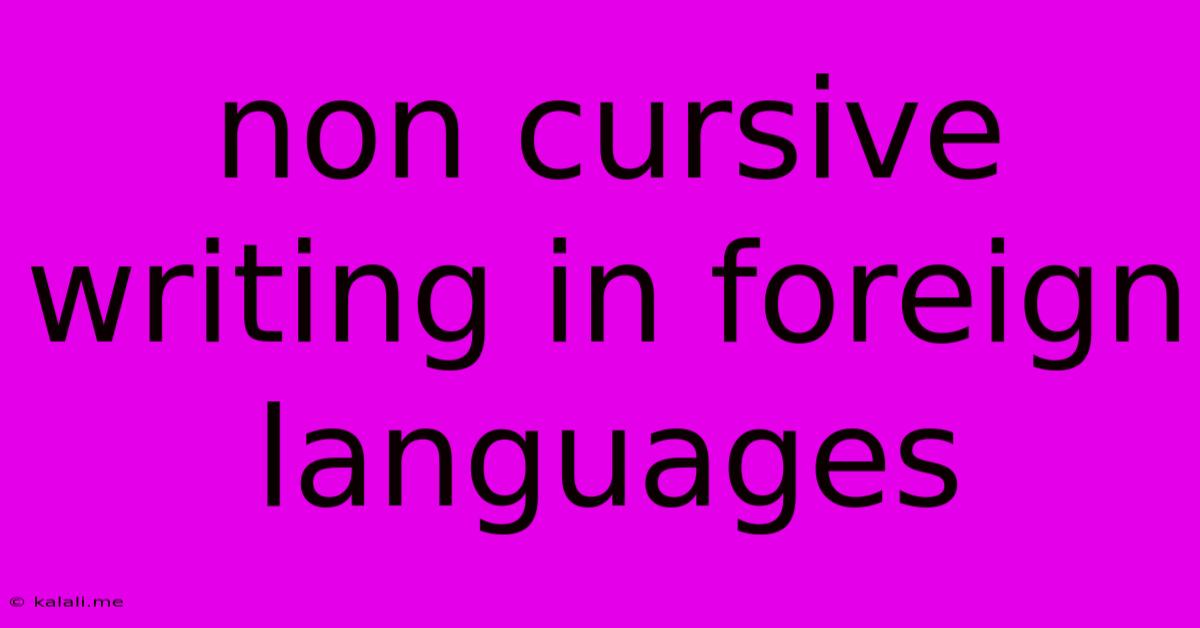Non Cursive Writing In Foreign Languages
Kalali
Jun 10, 2025 · 4 min read

Table of Contents
Navigating Non-Cursive Writing in Foreign Languages: A Comprehensive Guide
Meta Description: Learning to write foreign languages in print script? This guide explores the challenges and strategies for mastering non-cursive handwriting in diverse linguistic contexts, covering letter formations, spacing, and cultural nuances.
Writing in a foreign language presents unique challenges, even beyond mastering the vocabulary and grammar. For many learners, the transition from familiar cursive or print scripts to the non-cursive (print) script of a new language can be surprisingly tricky. This article delves into the intricacies of non-cursive writing in foreign languages, offering practical advice and insights for successful learning.
Understanding the Variations in Non-Cursive Scripts
The seemingly simple act of writing in print script isn't universally uniform. While the underlying principle – representing sounds with distinct symbols – remains consistent, the visual appearance of letters and their formations can vary significantly across languages.
-
Letter Shapes: Consider the difference between the lowercase 'g' in English and its counterpart in Spanish or French. These subtle variations, while seemingly minor, can significantly impact legibility and fluency in handwriting. Similarly, the formation of certain letters might be more angular or rounded depending on the language.
-
Spacing and Line Height: Appropriate spacing between letters and words is crucial for readability. What might be considered comfortable spacing in English might feel cramped or excessively wide in a language with different character widths or scripts. Maintaining consistent line height also contributes significantly to the overall appearance and clarity of your writing.
-
Diacritics and Special Characters: Many languages utilize diacritical marks (accents, umlauts, cedillas) and unique characters that aren't present in the English alphabet. Mastering the correct placement and formation of these marks is essential for accurate and understandable writing. For example, correctly placing an accent on a French 'e' is crucial to its pronunciation and meaning.
-
Cultural Nuances: Even beyond the technical aspects of letter formation, cultural norms might influence writing styles. Some cultures might prioritize neatness and precision, while others might place more emphasis on speed and efficiency. Understanding these nuances can improve the overall quality of your writing.
Strategies for Mastering Non-Cursive Foreign Language Writing
Successfully navigating the complexities of non-cursive writing in a new language requires a multifaceted approach. Here are several key strategies to consider:
-
Start with the Basics: Begin by focusing on the fundamental strokes and formations of each letter in the target language alphabet. Practice writing each letter repeatedly until you achieve consistency and accuracy.
-
Utilize Traceable Worksheets: Traceable worksheets are an effective tool for developing muscle memory and improving letter formation. They provide visual guidance and help build the necessary dexterity.
-
Practice Writing Simple Words and Sentences: Once you feel comfortable with individual letters, start practicing writing simple words and sentences. This allows you to practice spacing and letter combination.
-
Use Visual Aids: Flashcards, charts, and online resources can be invaluable tools for visualizing letter formations and practicing handwriting. These resources provide visual reinforcement and enhance retention.
-
Seek Feedback: Don't be afraid to seek feedback from native speakers or experienced language teachers. They can identify areas for improvement and offer valuable insights into stylistic nuances.
-
Embrace Technology: While handwriting is crucial, utilizing technology like language learning apps or word processors with handwriting recognition can provide additional practice and immediate feedback.
-
Focus on Legibility: Always prioritize legibility over speed. Neat and clearly written text is much more effective than rushed, illegible script.
Overcoming Common Challenges
Many learners encounter specific challenges when writing in non-cursive foreign languages. These include:
- Unfamiliar Letter Shapes: The unique shapes of letters in different alphabets require diligent practice and memorization.
- Diacritical Marks: Correctly placing and forming diacritics requires precise control and attention to detail.
- Spacing and Alignment: Maintaining consistent spacing and alignment requires careful attention and practice.
Overcoming these challenges requires patience, persistence, and consistent practice.
Conclusion
Mastering non-cursive writing in a foreign language is a significant achievement that enhances both your language skills and overall cultural understanding. By employing the strategies outlined above and maintaining a focused, persistent approach, you can confidently navigate the nuances of foreign language handwriting and achieve fluency in both spoken and written communication. Remember that consistent practice is key – the more you write, the more proficient you'll become.
Latest Posts
Latest Posts
-
What Can I Use Instead Of Aluminum Foil
Jun 10, 2025
-
How To Get Rock Smash In Pokemon Ruby
Jun 10, 2025
-
Big Data Crypto Able To Share Cpu
Jun 10, 2025
-
Dress Hanging Closet Comes Out From Wall
Jun 10, 2025
-
How To See Blocked Messages On Mac
Jun 10, 2025
Related Post
Thank you for visiting our website which covers about Non Cursive Writing In Foreign Languages . We hope the information provided has been useful to you. Feel free to contact us if you have any questions or need further assistance. See you next time and don't miss to bookmark.